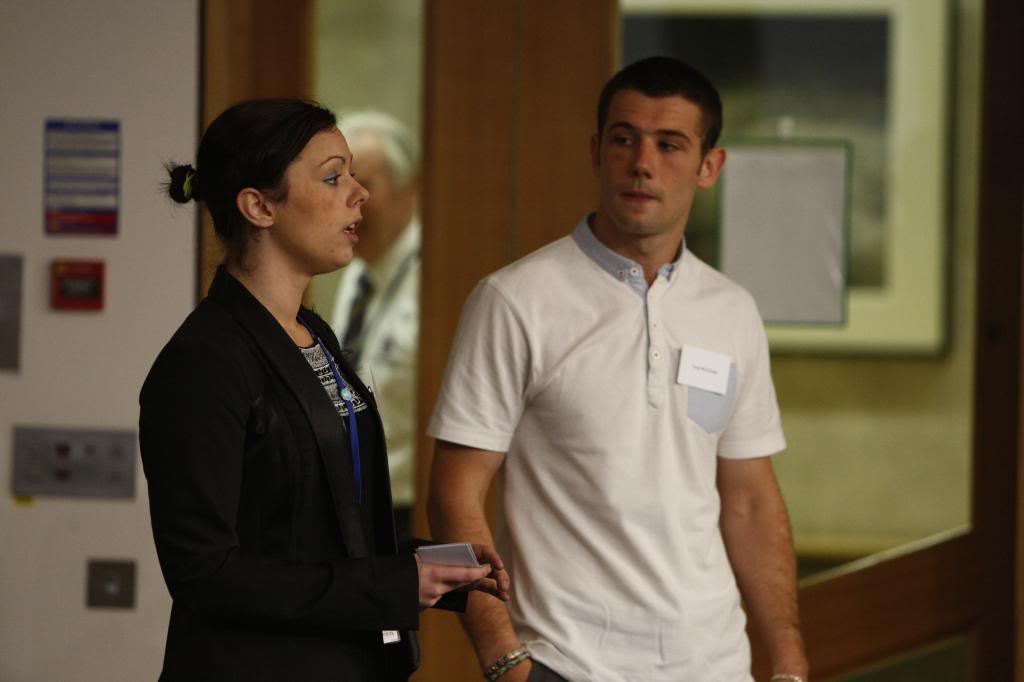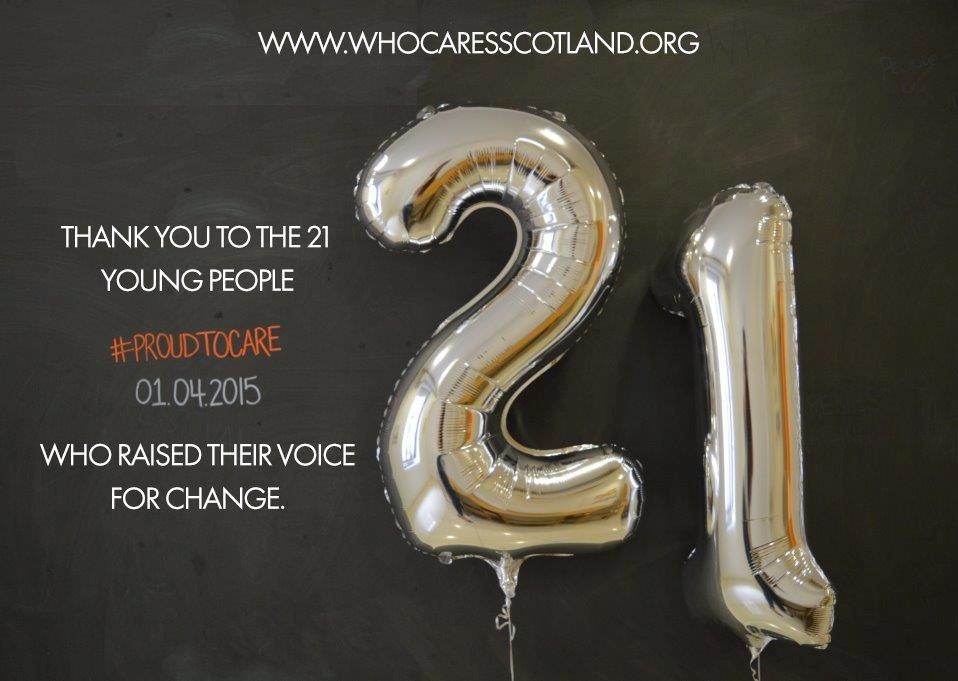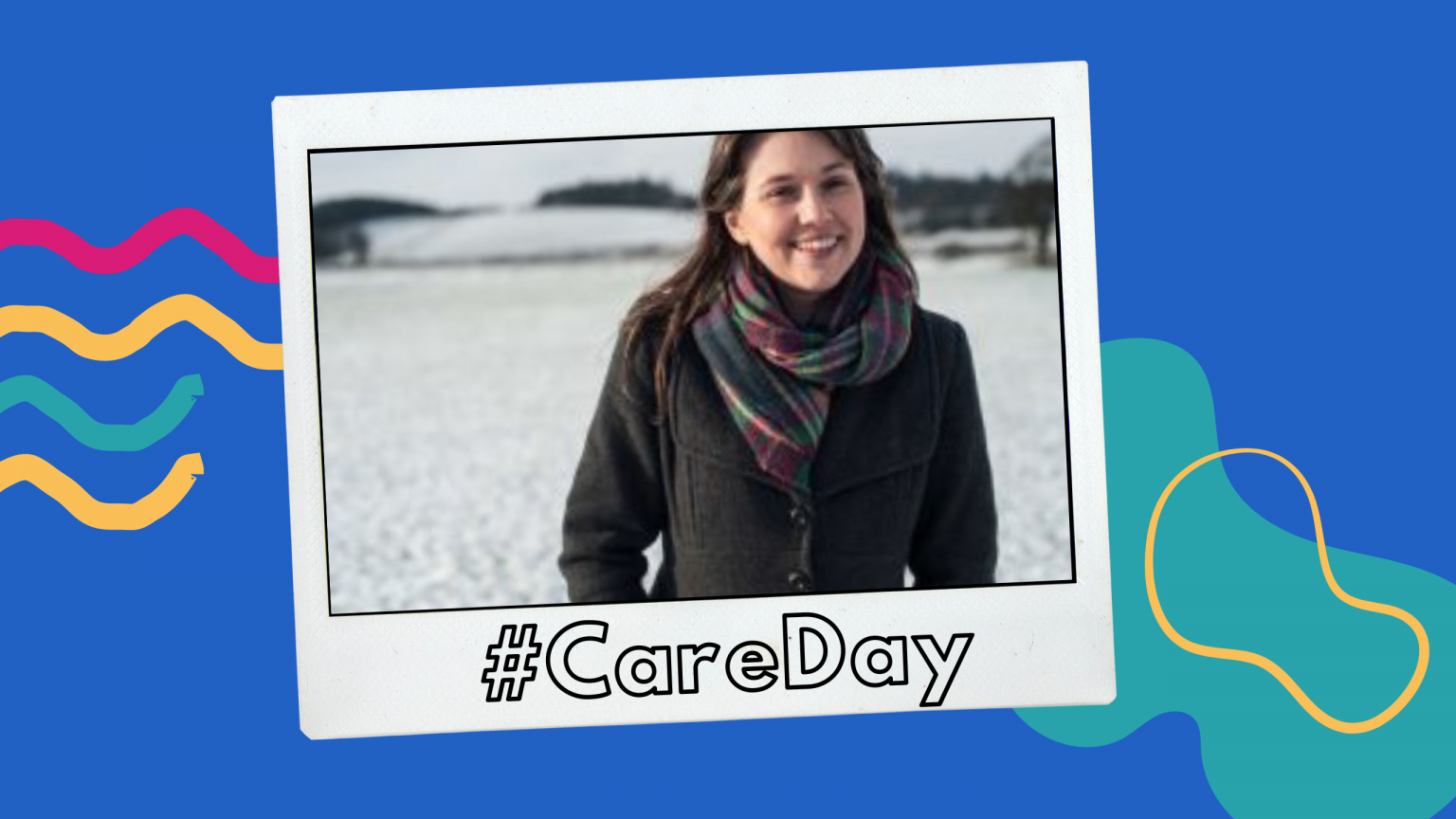A downloadable version of this report as well as a recordeded video interview with some of the Care Experienced campaigners is available at the end.
Introduction – setting the scene.
Who Cares? Scotland and political advocacy.
In late 2012 Who Cares? Scotland began to engage in active policy influencing at the political level, building on decades of individual advocacy and campaigning for rights within the world of social work. In Autumn 2012 they noticed that the Education and Culture Committee of the parliament was conducting an enquiry into the educational attainment of ‘looked after children’, asking for interested parties to submit evidence to the Committee. Who Cares? Scotland saw this as an opportunity for Care Experienced people to bring their experiences and voices directly to the MSPs. This was supported by the organisation’s new strategic plan, which was supported by staff and Care Experienced people members involved with the organisation.
During 2013, and because of the increased focus on Care Experienced people due to the committee inquiry and the Children and Young People (Scotland) Bill that was progressing through parliament, Claudia McDonald, the senior staff member responsible for communications, with the strong support of Chief Executive, Duncan Dunlop, began to coordinate with two other senior policy leads, Alex Cole-Hamilton, from Aberlour Child Care Trust and Mark Ballard from Barnardos Scotland. They aimed to get MSPs listening to the voices of Care Experienced children and young people.
For many years Who Cares? Scotland had been active in foregrounding the voices (that is the stories and opinions) of ‘looked after children and young people’ within the social work system; from running campaigns on pocket money to raising issues about physical restraint. They brought together children into local groups and national conferences, published a regular newsletter and magazine, and issued reports. Who Cares? Scotland has always had young people on its board of management, and recruited some staff who were themselves ‘Care Experienced’. So, they were an organisation with a huge knowledge of the care system. There were several issues that had been long-running troubles for young people in care – issues which had resisted change. One of them was the age of leaving-care – which was, and still is – often very difficult and even traumatic for young people in care. The other issue always raised by Care Experienced young people was their experiences of being separated from brothers and sisters – this was to become the focus of the next big political campaign – but that is a story for next year.
Legislation from 1995 and 2003 stated that young people should not be treated as care-leavers until their 18th birthday, yet in 2012 it was still routinely the case that 16- and 17-year-olds were making ‘planned moves’ from care – enacted by their social workers, under the guidance of senior management. The consequence was young people carrying tremendous burdens of responsibility and loss of a home, friendship and support. A transition to adulthood that was described as ‘compressed and accelerated’ (Stein, 2008) and was, for many, disastrous.
Alex Horne, one of the young ‘care-leavers’ who took part in meetings with MSPs was asked, ‘How did the age of leaving care become the main issue for Who Cares? Scotland at this time. He said,
"because it was what the young people wanted, what we spoke about. We decided. It was massive, you never left your family home at 16, the average age of leaving care was 17 and a half around Scotland, whereas the average age of leaving home was 25. Where’s the comparison, you couldn’t go back to a children home to get your washing done, something to eat."
Background to the care-leaving problem.
The Children’s Commissioner and the Sweet 16? Report on care-leaving.
Despite some pockets of good practice, and the intentions of the Children (Scotland) Act of 1995, the problems facing care-leavers had long been a matter of concern. In 2008 the first Scottish Children’s Commissioner, Kathleen Marshall, had instigated research into the dire situation of young people leaving care, and published a report, ‘Sweet 16? The age of leaving care in Scotland’. In it the Commissioner drew attention to the problems facing young people ‘leaving care too young’. Her analysis of the publicly available ‘looked after children’ statistics that are collected annually,
‘shows clearly that the most common age of leaving care is 16, despite the stated aims of law and policy. The number leaving care at 16 is 8 times the number leaving at 18’.
(SCCYP, 2008, p.22)
Rights to Care: legislation, government guidance and the reality.
Law and practice.
The Children (Scotland) 1995 Act is the main source of Scots law concerning children in public care. It was the source of law concerning ‘care-leaving’ until those aspects were substantially extended by the 2014 Act. It makes the welfare of the child the paramount consideration in decisions involving them, and it applied to all children in care up until the age of 18.
The transition from care was an issue which had been addressed in this law. There was nothing that said that young people had to leave care at 16. However, the law governing the operation of the Children’s Hearing system, did say that compulsory measures of care – ‘supervision orders’ issued by a Children’s Hearing, should normally stop at age 16. Thereafter children could remain in care on a voluntary basis until their 18th birthday. Furthermore, this Act gave local authorities the discretionary power to provide accommodation up until the child’s 21st birthday, and they had a duty to provide care-leaving support between the age of 18 and 19. That was the law, however, the practice was different, and it varied by from local authority to local authority. It seemed that in most places managers were keen to get older children moved on into ‘independent’ accommodation where they would have to take much more responsibility for their own care, while receiving some support from the ‘care leaving teams’.
For these reasons, and maybe partly because it had become a kind of ‘tradition’ that the adults in the system – the residential workers and foster carers, as well as social workers – felt that they had to start moving children on once they turned 16. Undoubtedly the issue of the costs of care – the financial constraints on social work departments – played a part too. As children’s homes became smaller, as foster care became more expensive, then the cost per child of a place got higher and higher. Certainly, it would have been difficult for an individual social worker to go against the grain and try to prevent their child from moving anywhere until they were at least 18.
Naturally, many young people were very ambivalent about this process, in fact most were hugely worried. Of course, they wanted to enjoy the benefits of no longer being a child, to have more choices, more freedom, to move into adulthood. But if they had any kind of relationship at all with their carers (in foster or group home) they approached their time of moving out with great trepidation and wanted to stay as long as possible. A few young people were so fed up with being in care that they jumped, naively, at the opportunity to leave – not truly understanding the consequences or that it would be impossible to return to care.
So, we can see from this that it was already expected in 1995 that children would remain in care until the age of 18, but in most cases on a voluntary basis. As the Commissioner pointed out, in fact the local authority was permitted to look after children in care until the age of 21 – a so-called ‘discretionary power’ rather than a duty. As a former social worker, David Anderson – one of the members of the Scottish Care Experienced History Month Steering Group – puts it,
‘The voluntary basis was always a cop-out. It meant if a child was showing resistance to anything, the social work department could argue they didn’t want the support that was being offered (at a time when they needed it most) - even if they were rejecting it because of the trauma they had been through in their lives.’
David Anderson, a Care Experienced ex-social worker
Pathways Planning guidance.
In 2003, Scottish local authorities were given the powers, and the financial resources, to provide certain care-leaving cash benefits which had formerly been provided by the Department of Work and Pensions, as part of the UK-wide system of social security (Scottish Executive, 2003). This action was part of a UK-wide development intended to give local authorities the money and the powers to provide cash support to care-leavers. This was intended to improve financial support and improve the care-leaving transition. Crucially, in terms of the Guidance that accompanied these regulations, the financial support was intended to start at age 18.
In 2004 the Scottish Executive1 issued detailed ‘Pathways Planning’ guidance, in connection with the new financial powers that local authorities had received. This pathway planning has since then become a significant feature of social work practice and is very familiar to all care–leavers. This requires a written assessment of a young person’s needs before they leave care. The Scottish Executive produced a set of written materials to help local authorities carry out this new duty, which emphasised the importance of the active participation of the young person. Every young person is to have a Pathway Co-ordinator, and may also request a Young Person’s Supporter to help them go through the process (Scottish Executive, 2004).
From all this we can see that by 2008, when the Sweet 16? report was published, there was a lot of law and guidance from the Scottish Government telling local authority social work departments what to do, and all of it was based on the assumption that young people would not be leaving care until they were 18 (unless it was very much in their interests to do so). The Commissioner herself said she was shocked to find out the reality and many others close to the situation were despairing.
‘I was shocked to learn that young people were still expected to leave care at 16. Having been involved in children’s rights for about 20 years, this was a longstanding issue that I thought had been dealt with. And certainly, at one, or even two, levels, this was true. It was true in terms of law, and it was true in terms of policy. What I was learning was that it was not true in practice.’
Sweet 16? The age of leaving care in Scotland, 2008, p.5
Local authority social work departments – the care-leaving services.
Local authorities had developed specific human resources, by setting up ‘care leaving teams’, including social workers and residential workers. As we have seen they were now using the standardised tools issued by the Scottish Government to conduct individual ‘pathways planning’, covering the support the young people would receive in relation to money, housing, education and social life. Some authorities had had care-leaving teams in place since the early 1990s, under the system of regional local authorities. [A 2-tier system of local government – of 12 Regional and 32 District councils – that operated in Scotland from 1975 to 1995. Social work was a responsibility of the Regional councils.]
Nevertheless, to see how bad the social work practice was – even in 2004 – the Leaving Care Guidance issued by the Scottish Executive said that local authorities should not place care leavers- in ‘bed and breakfast or hostel accommodation’, and that ‘Homelessness legislation should not be used as the main route for accessing accommodation for young people ceasing to be looked after’ (Scottish Executive, 2004). That was what was happening, at least in some places.
Typically, young care-leavers – at age 16, 17 or 18 -moved into ‘supported lodgings’, or shared flats or even their own tenancy and some were forced to access these homes via the homelessness services of their local authority. This was really poor, poor practice, and the responsibility of social work managers and councillors. They might have defended themselves by saying they did not have the money to provide better services – but it was still a terrible situation that social work managers seemed to tolerate for a long time. Some care-leaving team workers did network together and tried to argue for more resources.
So, there was a support service of sorts, which varied from local authority to local authority. This variation in housing options and levels of personal support was extremely frustrating to the care-leavers who met each other through the Who Cares? Scotland networks – some people seemed to get good support and good housing options, others didn’t. These care-leaving teams attempted to provide personal support and various forms of ‘supported accommodation’ to care leavers. However, it was widely acknowledged that these forms of support were very inadequate – in that care-leavers did not feel very well supported and had too much responsibility for managing accommodation (their own or a shared flat), and other issues such as managing money to live on or accessing education or training. Of even greater significance was the sense of loneliness that many care leavers experienced on transition from residential house or foster care. Managing relations with siblings, parents and other family members is also a crucial aspect of life post-care, and this area did not seem to be supported at all – care-leavers were assumed capable of, and responsible for, maintaining current family relationships or re-connecting with family members.
The volume and quality of leaving care support often seemed to fail those who needed it most. Leaving care workers were most successful with the young people who were most responsive to offers of help, and most capable of adapting to the very challenging situation they found themselves in. Others were described as ‘difficult to engage’, or as falling through the cracks. Many young care-leavers were in desperate circumstances soon after leaving care. Residential workers, and Throughcare staff, were reporting continuing numbers of care leavers becoming homeless, impoverished or in debt, some were committing suicide or dying from drug overdoses – which were often suspected to be suicide. Many others were self-harming, sad and isolated. Other young care-leavers were well aware of those who were struggling, and nearly all older care-leavers report encountering great difficulties at this time in their lives. (Dixon and Stein, 2002; Cowan, 2008; Furnivall, 2013).
We must ask why this was the situation – was it due to cost considerations, was it a ‘washing the hands of responsibility’? Perhaps it was that ‘formerly looked after children’ simply fell down the priority list. This is a bleak assessment of motives, but there is no doubt that many young people experienced a profound, and wounding, sense of abandonment by the social work system, of being neither cared for nor cared about.
How we tell this story.
It should also be noted – in any piece of writing like this – that some care leavers thrived, either immediately after leaving care, or – after a rocky patch – a few years later. Certainly, it is now known from research into higher education that many Care Experienced people do enter F/HE in their 20s or 30s, and not many straight from school. So, it is important that any writing on care-leaving, or indeed the in-care experience, should not give the impression that the experience was always terrible and always led to disastrous consequences. The Frameworks institute has produced a valuable report suggesting ways that we all should begin to ‘re-frame’ how we talk about the lived experience of care – in particular to avoid sticking to an entirely negative view. You can find out more here.
However, it cannot be denied that many young people had a terribly difficult transition, and that those policies and support services which existed to support ‘care-leavers’ were completely inadequate for the task. And no wonder, the great majority of care-leavers were leaving at 16 or 17 never mind 18. Some Non-Government Organisations provided additional services for care-leavers, although this varied widely across the country. Repeated pieces of research or advocacy in this area emphasise that the fundamental problem was leaving care too early, and losing relationships with friends and carers. While there was agreement that better help with housing, education and employment, and building up a social/family network was needed, the transition to adulthood and ‘independence’ had to be accompanied by the continuance of caring relationships, to be more gradual and to last much longer.
The focus of the campaign – a global movement.
Thus, the age of leaving care, and the need for legislative change began to be crystallised as the focus of campaigning when the young people managed to gain a hearing from the MSPs. Parallel campaigns were happening within the other care systems in all parts of the UK. In England and Wales, the campaign to support care-leavers was called the ‘Staying Put’ campaign, with the idea that children in foster-care should not be pushed out on their 18th birthday, if they wanted to and their foster carers wanted them. Sadly, and controversially, this policy of ‘Staying Put’ was not extended to children in residential care in England. Latterly Staying Put also became the name of the Scottish policy of not requiring young people to leave their placement at age 18, and in Scotland it applies to all children, no matter their type of care ‘placement’. The period from 18 to 21 one is now described from a social work point of view as a ‘continuing care’ placement.
All this was part of a growing global movement to recognise the rights of care-leavers for continuing support. In 2009, a UN guidance document, ‘Guidance for the Alternative care of Children’, outlined all the factors which should be taken into account when providing care for children separated from their parents, and it included statements about the rights of care-leavers (United Nations General Assembly, 2009).
Persuading MSPs to listen directly to the voices of children and young people in care.
As noted at the start of this report an important factor in the campaign for raising the care leaving age, was the network of three experienced campaigners: Claudia Macdonald, Mark Ballard and Alex Cole-Hamilton. These three had a considerable knowledge of the politics and processes of the Scottish parliament. Each of their organisations had recognised the opportunity presented by an enquiry the Children and Culture Committee of the Scottish Parliament was undertaking on the subject of the educational attainment of children in care, and how they compared to those of their peers not in care.
So when the Committee issued an invitation for evidence to their enquiry Who Cares? Scotland decided to respond. Duncan Dunlop the recently appointed CEO of Who Cares? Scotland and Claudia, who was the senior Communications Officer, felt that Who Cares? Scotland had little connection with MSPs but that their relationships with care-leavers and young people in care meant they had a lot of messages to bring to the MSPs.
The letter to the MSPs and the December 12th meeting: listening to young people’s stories.
So, the staff of Who Cares? started consulting young people, including some who had been taken on as employees and trainees. The result was that the young people, with the support of Duncan, responded to the invitation issued by the Education and Culture Committee and laid down a challenge to the MSPs based on the slogan used by many excluded groups– ‘nothing for us without us’. They replied to the Committee’s invitation with a letter of their own – signed by 21 young people and the Chief Executive. In it they asked the MSPs to listen directly to their stories and also requesting the MSPs to come to where they would be comfortable- and not to force them to come to the parliament.
As Ashley Cameron, a 22-year-old activist at this time, put it,
‘The reason we asked them to come to our space was because the Scottish Parliament was so alien to us.’
After a considerable amount of behind the scenes conversations between Claudia and the MSPs teams and parliamentary officials, the chair of the Committee, Stuart Maxwell MSP, agreed that three MSPs from the Committee including himself, would come to the Who Cares? Scotland offices on the evening of 12th December 2012, to listen to what they had to say. This would be an informal event, and not recorded, as meetings of Committees usually were.
This meeting was to prove a momentous event – Who Cares? Scotland staff worked with groups of the children and young people and prepared a plan to speak to the MSPs and their advisers. The young people felt that they could not narrowly talk about education outcomes, they had to give the MSPs a picture of life in three phases; before, during and after care – and that wider focus might help explain why so few children from care had many qualifications by the time they left school. The young people were divided into three groups and each group were prepared and supported by Who Cares? Scotland staff to tell their own story under one of these headings – in three different spaces in the offices.
Ashley, who was 22 at the time, was in the ‘pre-care’ group, and this had involved her telling the visitors about her family life before she came into care. This was upsetting at points, but she felt it was important to share her reality. All the stories had a powerful impact on the visitors –as Alex Horne says it was emotional, but they were prepared for it. The young people had decided beforehand that this was an important opportunity and that the MSPs, their staff and civil servants, should not get a sanitised version of their lives. They should learn about the ‘system’ from their perspective – and not be told about how it should be, but how it really was. Everyone who was present agrees that this meeting was effective in terms of informing and impacting the MSPs. One of those MSPs, Neil Findlay talks about the 12th of December meeting in this way,
‘It will live in my mind for ever. That day was profoundly important. It completely changed the course of the enquiry (into educational attainment). Hearing about real lives was far more powerful than reading reports. It affected all of us.’
Neil Findlay MSP, interview for Care Experienced History Month
The impact of this meeting, and the reporting back to their committee by the MSPs present that evening meant that Who Cares? Scotland had won the trust of the MSPs on the Education and Culture Committee. The other MSPs wanted to get their opportunity to hear directly from Care Experienced children and care leavers. The Committee was given the job of scrutinising the Children and Young People (Scotland) Bill in April 2013 and so it was that a mere two months into that task, two groups of children and young people, continued the work of the December meeting and travelled through to Edinburgh to give evidence to the committee on the record, ‘in closed session’ (meaning that it was not open to the general public as such meetings usually were). The December meeting had been largely composed of older children in care and care-leavers, while the June meetings were split between a younger group of school age children, the youngest, Claymore Corcoran, being 12-years old, and the older group including the care-leavers. One of the ways the younger group presented their messages was via a short dramatisation, using the words they had collected from many of their peers in care. Claymore remembers being very excited about travelling to Edinburgh and watching the drama. Although at the time he did not really understand much about the Bill process, he is very glad to have been part of it.
Changing the Children and Young People (Scotland) Bill – more meetings with MSPs.
The Scottish Government had announced a Children and Young People Bill in August 2012. Like many such Bills it would encompass a number of issues, related to children, child protection and the role of social work and other services. The Bill would tackle issues such as the ‘named person’ proposal, which was becoming highly controversial, and in general put the whole GIRFEC approach and the concept of Corporate Parenting on a statutory basis.
It is noteworthy that the topic of ‘care-leaving’ did not feature in the initial drafting of the Bill, and indeed the initial topic which the MSPs from Education and Culture Committee proposed to discuss was on ‘entry to care’, which had arisen as an issue for social work departments and local authorities following a period of increasing numbers of children being taken into care.
As already noted in May the Education and Culture Committee was appointed as the lead committee to scrutinise the bill. This Committee made up from MSPs of all parties had to examine the Bill and present amendments which would be voted on by the whole parliament. See below for the stages of the bill and the dates these stages were passed. By now they had been impacted by the voices of Care Experienced children and young adults. They were ready to listen some more.
That year there continued to be a series of meetings and campaigning events as the Who Cares? Scotland and the young campaigners sought to keep up the pressure on the MSPs to introduce a new right to stay in care until 21. Some of the older, most articulate campaigners, among them Ashley Cameron began to receive invitations to meet with civil servants who were now keen to get their perspectives. Who Cares? Scotland also kept up its lobbying operation and Ashley and Alex were back in parliament just before Christmas 2013, handing out information to MSPs about their ‘Christmas Wishlist’ campaign which included raising the care-leaving age. Who Cares? Scotland had learned that this was a crucial point in the progress of the Bill, and the Scottish Government was going to make a decision early in the New Year about whether it would accept an amendment to the Bill to create a new right to Continuing Care up to the age of 21.
Specific MSPs, including the Minster for Children and Young People, Aileen Campbell, and other leading MSPs like Kezia Dugdale, also aimed to understand for themselves what Care Experienced people were saying, and sought out meetings with those of the young people who they had heard about. The three Policy Officers in the ‘informal coalition’ were also maintaining contacts with civil servants and began to propose a new section of the Bill, which would ultimately be called the Continuing Care section – which established the right to remain in care until the age of 21, with further rights to support (at the discretion of the local authorities) up to the age of 25. The Care Experienced People were having a massive impact.

The parliamentary process, and the timeline of the Children and Young People (Scotland) Bill.
The following section of this report gives the parliamentary timeline of the 2014 Act. The information is taken from a parliamentary leaflet, the Children and Young people Bill Summary, issued by the Scottish Parliament Information Service (SPICe).
The legislative process is based on the idea that Parliament itself should be strong, that the people of Scotland from all walks of life, pressure groups, and regions should participate and share power. A key element of the process is to ensure openness and encourage participation.
Pre-legislative process – April – December 2012
This pre-legislative consultation is designed to be open and participatory, allowing access to the decision-making process.
Stage 1 – Bill introduced to parliament on April 17 2013
Government drafted the Bill and sent it to the Education and Culture Committee – which has MSPs from all parties.
If Parliament agrees then the bill will proceed – Agreed on 21 November 2013
Stage 2
The bill then undergoes more detailed “line-by-line” scrutiny, either by the appropriate Committee, the whole Parliament, or a combination of the two. Amendments (changes) may be made at this stage.
If parliament agrees then the Bill proceeds – Agreed on 21 January 2014
Stage 3
The bill is considered by the whole Parliament.
Amendments can be made at this stage –Passed on 19th February 2014.
Royal Assent 27th March 2014.
Victory?
Rights to care, accommodation and support to 21, and the possibility of this support continuing to the age of 25 at the discretion of the local authority, were achieved through the 2014 Act. Some services have improved, but…while some young people are definitely able to stay on it is still not happening for all those who want it. The Scottish Throughcare and Aftercare Forum – www.staf.scot is working hard with all partners but latest figures show just 300 young people in Continuing Care placements out of 6000+ who are eligible as of 2018-19. Some local authorities are reported to be saying that they don’t have enough places for young people to stay.
Many Care Experienced people grew in confidence and stature and took up roles in employment and public life that they would not have considered or been able to access previously. Ashley Cameron says the campaign ‘liberated the voice’ of Care Experienced people and certainly people with care experience have been much more visible in public life and politics – such as the widely supported ‘Listen Pledge‘ launched in 2016 and taken up by the First Minister, Nicola Sturgeon, in 2017 when she pledged to listen to 1000 experienced people during the 4-year term of that parliament which ended this month, April 2021.

The ‘Care Experienced campaign’ campaign won several awards,
Young Scot Community Award and overall Winner award
The Herald Politics Awards – Campaign of the Year.
Who Cares? Scotland won the ‘Charity of the Year’ award from SCVO. The very concept of ‘Care Experienced people’ as an identity was developed – an identity to be claimed and affirmed and have pride in. Increasing numbers of care-experienced people are acknowledging, rather than hiding their care story.

All this laid important groundwork for continuing advocacy which emphasised a high-level of participation of Care Experienced people in system reform – such as the Independent Care Review, 2018 -2020, and The Promise follow-up work.
There was also much impact from the ‘Corporate Parenting’ duties in the same Act and the development of numerous local authority ‘Champions Boards’ to allow young people in care to continue to speak directly to local authority members (councillors) and employees in the local authorities where they are cared for. Having seen how Care Experienced young people had influenced the Scottish Parliament, the local authorities knew that they had to listen much more closely to what the young people themselves were saying.
We cannot say that all young people in care now get the kind of support to which they are now entitled, to help them manage the transition into adulthood and world of work and further education. But the achievements and successes of the 2012-13 campaign by care-experienced people created both new rights and continued to influence MSPs from all parties and the Scottish Government right up to the present day.
They did some job!
In Conversation with Ashley and Alex.
Below is a recording of a live Q&A event with Ashley Cameron and Alex Horne, two of the Care Experienced activists involved in influencing the Children and Young People (Scotland) Act 2014. Hosted by Dr Ian Milligan as part of Care Experienced History Month.
References:
Dixon, J. & Stein, M. (2002). Still a Bairn: Throughcare and Aftercare Services in Scotland. (University of York. York).
Scotland’s Commissioner for Children and Young People (SCCYP). (2008). Sweet 16? The age of leaving care in Scotland. SCCYP: Edinburgh.
Scottish Executive. (2003). Support and Assistance of Young People Leaving Care (Scotland) Regulations 2003.
Scottish Executive. (2004). Supporting Young People Leaving Care in Scotland: Regulations and Guidance on Services for Young People Ceasing to be Looked After by Local Authorities. Edinburgh: Scottish Executive, 2004b.
Stein, M. (2008). Resilience and young people leaving care. Child Care in Practice, 14(1), p.35-44. DOI:10.1080/13575270701733682
United Nations General Assembly. (2009). Guidelines for the Alternative Care of Children: Adopted by the General Assembly 24 February 2010.
Sources and acknowledgements:
This report was written by Dr Ian Milligan with many contributions from members of the Scottish Care Experienced History Month Steering group – David Anderson, Amy-Beth Miah and Lorna Goodbrand. Much help was provided by Melissa Craib and Charlotte Armitage – Who Cares? Scotland staff responsible for the Care Experienced History Month project and supporting the Scottish Steering Group.
The report is based on interviews with those who were there, including:
The Care Experienced activists:
Alex Horne
Ashley Cameron
Claymore Corcoran
Who Cares? Scotland staff:
Denny Ford
Claudia Macdonald
Thomas Carlton
MSPs:
Neil Findlay MSP








